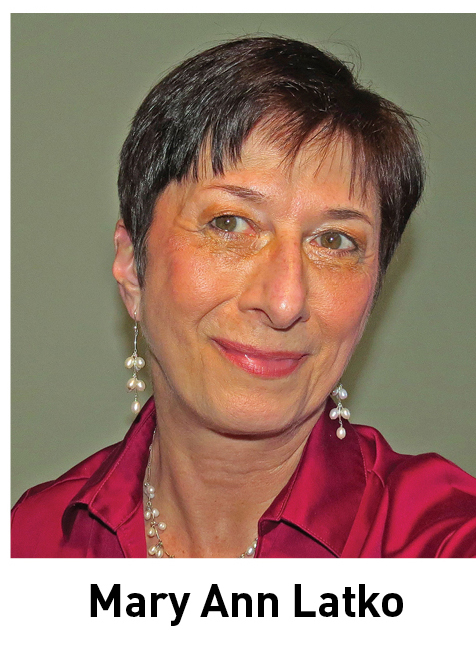DEPARTMENTS
AN AIHA FAREWELL

Finding Her Way in a “Found” Profession
From December 2015 through the end of this year, AIHA is saying farewell to four senior managers. Profiles of each retiree will appear in The Synergist prior to their departures. This month, we feature Mary Ann Latko, CAE, CIH, CSP, QEP, who is AIHA’s managing director of Scientific and Technical Initiatives, Proficiency Analytical Testing Programs, and Registry Programs. Latko’s last day at AIHA will be March 31.
Mary Ann Latko was sure of two things: she probably wouldn’t get the job at AIHA; and, if she did, she wouldn’t stay long. The year was 2004, and AIHA was searching for someone to lead its Scientific and Technical Initiatives (STI) department.
“I never thought in a million years that I’m the kind of person they would hire, because I wasn’t active in AIHA,” Latko recalls. “I was a corresponding member of the Indoor Environmental Quality and Computer Applications committees, but I was never really active.”
Nor was she one to stay with a job for the long haul. After earning her master’s in environmental engineering, she’d gone to work in the pharmaceutical industry. She fell into IH in the mid-1990s while at an IAQ consulting firm before moving to Aon, the insurance brokerage firm, where she managed an online auditing tool.
Then, to her surprise, she got the job at STI. And today, she’s just as surprised that a dozen years have come and gone.
“This is the longest I’ve ever stayed anyplace,” Latko says of her time at AIHA. “All of my other stints have been five years or less. I never thought I’d be here twelve years.”
In those twelve years, the one-time “mailbox member” has led development of some of the association’s most innovative projects, which have the potential to benefit AIHA members and the IH profession long after Latko retires at the end of this month.
EARLY SUCCESS AND NEW STARTS
One of Latko’s early successes at AIHA was the creation of “working groups”—a kind of volunteer group that exists outside the traditional committee structure. The AIHA bylaws restrict committee service to AIHA members; the working groups allow allied professionals to work alongside AIHA members on mutually important issues. The first two working groups, for healthcare and nanotechnology, were rousing successes, growing rapidly in a matter of months. Today, AIHA has additional working groups in green building, incident preparedness and response, mining, and oil and gas.
In 2009, Latko was tasked with leading the AIHA Proficiency Analytical Testing Program (PAT) and the AIHA Registry Programs. PAT had been promoting laboratory quality for decades, but Registry offered opportunities to build new programs from scratch. Each registry involved the creation of a body of knowledge and a related assessment through which registrants demonstrate competency in specific areas.
The SDS & Label Authoring registry was developed in partnership with the Society for Chemical Hazard Communication; its registrants include toxicologists as well as industrial hygienists and other professionals. The Exposure Decision and Analysis registry is geared toward early career professionals and is intended, in part, to keep student members engaged with AIHA after graduation. And the 4-Gas/PID registry focuses primarily on non-IHs who are doing IH work. “They’re making life-and-death decisions,” Latko says of this group. “You want them to be competent.”
Latko experienced another new start in 2012 when AIHA tasked her with managing the “new” STI, which focuses on developing partnerships and conducting research. Much of that research was incorporated into three bodies of knowledge released in 2015—on indoor air quality/indoor environmental quality, respiratory protection and fit-testing, and direct-reading instruments for detection of gases and vapors.
“We’ve now developed a process that we’re going to be able to use to continue to go forward” with other BoKs, Latko says. “That is, I think, very good for AIHA, and I think our volunteers really enjoy it.”
AHEAD OF THE CURVE
It’s clear that Latko enjoys it, too. So why is she leaving? It’s simply time, she says.
“My standing line is that the last payment is due April 1 to the University of New England,” from which her younger son will soon graduate with a degree in marine science. “But yes, it’s been a long time. I’ve been working nonstop since I was 13 years old, and I just want to take a few months and not do a whole lot.”
As difficult as it was, in 2004, for Latko to imagine that her AIHA career would span a dozen years, it’s just as satisfying for her to reflect on how the profession and the association have changed over that time.
“It’s definitely become broader and more forward- thinking,” Latko says of the profession. “We’re not all people who come from bachelor’s and master’s degrees in industrial hygiene. In many ways it’s kind of a ‘found’ profession, that people coming out of a different career or a different educational background move into. I think that diversity and that high level of engagement and education really positions us to stay ahead of the curve.”

thesynergist | TOC | NEWSWATCH | DEPARTMENTS | COMMUNITY

